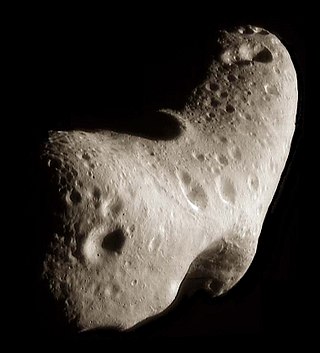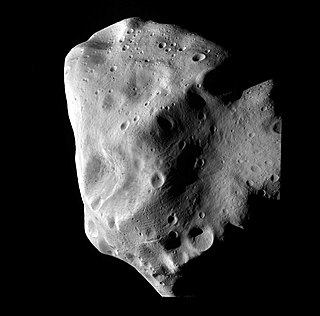Related Research Articles
A V-type asteroid or Vestoid is an asteroid whose spectral type is that of 4 Vesta. Approximately 6% of main-belt asteroids are vestoids, with Vesta being by far the largest of them. They are relatively bright, and rather similar to the more common S-type asteroid, which are also made up of stony irons and ordinary chondrites, with V-types containing more pyroxene than S-types.

S-type asteroids are asteroids with a spectral type that is indicative of a siliceous mineralogical composition, hence the name. They have relatively high density. Approximately 17% of asteroids are of this type, making it the second-most common after the carbonaceous C-type.

C-typeasteroids are the most common variety, forming around 75% of known asteroids. They are volatile-rich and distinguished by a very low albedo because their composition includes a large amount of carbon, in addition to rocks and minerals. They have an average density of about 1.7 g/cm3.

M-type asteroids are a spectral class of asteroids which appear to contain higher concentrations of metal phases than other asteroid classes, and are widely thought to be the source of iron meteorites.

E-type asteroids are asteroids thought to have enstatite (MgSiO3) achondrite surfaces. They form a large proportion of asteroids inward of the asteroid belt known as Hungaria asteroids, but rapidly become very rare as the asteroid belt proper is entered. There are, however, some that are quite far from the inner edge of the asteroid belt, such as 64 Angelina. They are thought to have originated from the highly reduced mantle of a differentiated asteroid.
P-type asteroids are asteroids that have low albedo and a featureless reddish spectrum. It has been suggested that they have a composition of organic rich silicates, carbon and anhydrous silicates, possibly with water ice in their interior. P-type asteroids are found in the outer asteroid belt and beyond. There are in the neighborhood of 33 known P-type asteroids, depending on the classification, including 46 Hestia, 65 Cybele, 76 Freia, 87 Sylvia, 153 Hilda, 476 Hedwig and, in some classifications, 107 Camilla.

Rhodope is a dark background asteroid from the central region of the asteroid belt, approximately 55 kilometers in diameter. It was discovered on 15 August 1876, by German–American astronomer Christian Peters at the Litchfield Observatory in Clinton, New York, United States. The asteroid was named after Queen Rhodope from Greek mythology.

Edburga is a typical Main belt asteroid. Max Wolf discovered it on 7 January 1896 at Heidelberg Observatory. The origin of the name is unknown. This asteroid is orbiting the Sun at a distance of 2.58 AU with a period of 4.15 yr and an eccentricity of 0.34. Its orbital plane is inclined at an angle of 18.7° to the plane of the ecliptic.

An asteroid spectral type is assigned to asteroids based on their reflectance spectrum, color, and sometimes albedo. These types are thought to correspond to an asteroid's surface composition. For small bodies that are not internally differentiated, the surface and internal compositions are presumably similar, while large bodies such as Ceres and Vesta are known to have internal structure. Over the years, there has been a number of surveys that resulted in a set of different taxonomic systems such as the Tholen, SMASS and Bus–DeMeo classifications.
L-type asteroids are relatively uncommon asteroids with a strongly reddish spectrum shortwards of 0.75 μm, and a featureless flat spectrum longwards of this. In comparison with the K-type, they exhibit a more reddish spectrum at visible wavelengths and a flat spectrum in the infrared.
The rare O-type asteroids have spectra similar to the unusual asteroid 3628 Boznemcová, which is the best asteroid match to the spectra of L6 and LL6 ordinary chondrite meteorites. Their spectra have a deep absorption feature longward of 0.75 μm.
Athalia, provisional designation 1903 ME, is a carbonaceous Themistian asteroid from the outer regions of the asteroid belt, approximately 40 kilometers in diameter. It was discovered on 20 September 1903, by German astronomer Max Wolf at the Heidelberg Observatory in southwest Germany. The asteroid was named after the ancient Judahite queen Athaliah.
779 Nina is a large background asteroid, approximately 80 kilometers in diameter, located in the central region of the asteroid belt. It was discovered on 25 January 1914, by Russian astronomer Grigory Neujmin(1886-1946) at the Simeiz Observatory on the Crimean peninsula. The metallic X-type asteroid with an intermediate albedo has a rotation period of 11.2 hours. It was named after the discoverer's sister, Nina Neujmina (Tsentilovich) (1889–1971).
973 Aralia is an asteroid of the Ursula family located in the outer regions of the asteroid belt, approximately 52 kilometers in diameter. It was discovered on 18 March 1922, by German astronomer Karl Reinmuth at the Heidelberg Observatory in southern Germany. The Xk-type asteroid has a rotation period of 7.3 hours. It was named after the genus of ivy-like plant Aralia, also known as "spikenard".
1998 Titius, provisional designation 1938 DX1, is a metallic–carbonaceous asteroid from the inner regions of the asteroid belt, approximately 14 kilometers in diameter.
1139 Atami, provisional designation 1929 XE, is a stony asteroid and sizable Mars-crosser, as well as a synchronous binary system near the innermost region of the asteroid belt, approximately 9 kilometers in diameter. It was discovered on 1 December 1929, by Japanese astronomers Okuro Oikawa and Kazuo Kubokawa at the Tokyo Astronomical Observatory near Tokyo. It was named after the Japanese city of Atami. It has the lowest Minimum orbit intersection distance (MOID) to Mars of any asteroid as large as it, its orbit intersecting only 0.03 astronomical units from the planet.
1155 Aënna, provisional designation 1928 BD, is an asteroid from the inner regions of the asteroid belt, approximately 11 kilometers in diameter. It was discovered on 26 January 1928, by German astronomer Karl Reinmuth at Heidelberg Observatory in southwest Germany. It is named for the astronomy journal Astronomische Nachrichten.

7604 Kridsadaporn, provisional designation 1995 QY2, is an unusual, carbonaceous asteroid and Mars-crosser on a highly eccentric orbit from the outer regions of the asteroid belt, approximately 12 kilometers (7.5 miles) in diameter. It was discovered on 31 August 1995, by Australian astronomer Robert McNaught at Siding Spring Observatory near Coonabarabran, Australia. Due to its particular orbit, the C-type asteroid belongs to MPC's list of "other" unusual objects, and has been classified as an "asteroid in cometary orbit", or ACO. The asteroid was named in memory of Thai astronomer Kridsadaporn Ritsmitchai.
1318 Nerina, provisional designation 1934 FG, is a Phocaea asteroid from the inner regions of the asteroid belt, approximately 13 kilometers in diameter. It was discovered on 24 March 1934, by South African astronomer Cyril Jackson at the Union Observatory in Johannesburg. The possibly metallic X-type asteroid has a notably short rotation period of 2.5 hours. It was named for the flowering plant Nerine, also known as "Guernsey lily" or "Jersey lily".
3628 Božněmcová, provisional designation 1979 WD, is a rare-type asteroid from the middle region of the asteroid belt, approximately 7 kilometers in diameter. It was discovered on 25 November 1979, by Czech astronomer Zdeňka Vávrová at Kleť Observatory in the Czech Republic. It is named for Czech writer Božena Němcová.
References
- 1 2 3 4 Fornasier, S.; Clark, B. E.; Dotto, E. (July 2011). "Spectroscopic survey of X-type asteroids". Icarus. 214 (1): 131–146. arXiv: 1105.3380 . Bibcode:2011Icar..214..131F. doi:10.1016/j.icarus.2011.04.022.
- S. J. Bus & R. P. Binzel (2002). "Phase II of the Small Main-belt Asteroid Spectroscopy Survey: A feature-based taxonomy". Icarus. 158 (1): 146. Bibcode:2002Icar..158..146B. CiteSeerX 10.1.1.537.7488 . doi:10.1006/icar.2002.6856.